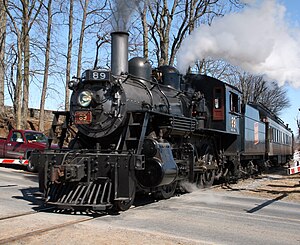Canadian National 89
| Canadian National 97 | |||||||||||||||||||||||||||||||||||||||
|---|---|---|---|---|---|---|---|---|---|---|---|---|---|---|---|---|---|---|---|---|---|---|---|---|---|---|---|---|---|---|---|---|---|---|---|---|---|---|---|
 No. 97 hauling an excursion train at the Beverly Valley Rail Road on February 4, 2020 | |||||||||||||||||||||||||||||||||||||||
| |||||||||||||||||||||||||||||||||||||||
| |||||||||||||||||||||||||||||||||||||||
| |||||||||||||||||||||||||||||||||||||||
| |||||||||||||||||||||||||||||||||||||||
Canadian National 97 is a 2-6-0 "Mogul" type steam locomotive originally built by the Canadian Locomotive Company in December 1910 for the Canadian National Railway. It is now owned and operated by the Beverly Valley Rail Road outside of Beverly, Massachusetts, where it resides today for use on excursion trains.
History[edit]
Revenue service[edit]
No. 89 was originally built in February 1910 by the Canadian Locomotive Company in Kingston, Ontario, for the Grand Trunk Railway as No. 1009.[1] It has a wheel arrangement of 2-6-0.[2] In 1919, it was renumbered to No. 911.[2] In 1923, the Grand Trunk was merged into the Canadian National Railway (CN) with No. 911 being one of the thousands of locomotives working for this new railroad. In 1951, No. 911 was renumbered to No. 89. Most of 89's career on the CN is unknown; it appears that it spent the latter part of its working life in Quebec before being retired in late 1958 and being stored in a deadline of locomotives in Montreal.[2][3]
Green Mountain Railroad[edit]
In 1961, No. 89 was purchased by New England seafood magnate and steam locomotive collector F. Nelson Blount and moved to North Walpole, New Hampshire, in the United States. No. 89 found a home in the former Boston & Maine North Walpole roundhouse and starting in 1965, would begin operating on the Green Mountain Railroad and would be moved to across the Connecticut River to Bellows Falls, Vermont. No. 89 quickly became Blount's favorite locomotive and he would often be found at the throttle until his death in 1967.[1]
Strasburg Rail Road[edit]
In June 1972, the Green Mountain Railroad sold No. 89 to the Strasburg Rail Road outside of Strasburg, Pennsylvania.[1] This is a linear village along the Great Conestoga Road, stretching about two miles along path later known as the Strasburg Road. The population was 2,809 at the 2010 census. The move from Bellows Falls to Strasburg was overseen by Strasburg employee Linn Moedinger. During a stopover in Penn Central's Buttonwood Yard in Wilkes-Barre, No. 89 was stranded when Hurricane Agnes caused the Susquehanna River to flood much of the area. No. 89 spent several days submerged in the rail yard but emerged with little to no damage.[4][5]
Upon arrival at Strasburg in July 1972, No. 89 underwent an overhaul and made its first official run for Strasburg Rail Road on March 17, 1973.[6] When No. 89 first arrived, it originally faced East when hauling excursion trains, it would remain that way until the turntable at the Railroad Museum of Pennsylvania was installed in late 1973. No. 89 frequently operated in tandem with Pennsylvania Railroad 4-4-0 No. 1223 on Strasburg's half-hour trains until it was taken out of service in the early 1980s for major repairs. During these repairs which lasted the majority of the decade, No. 89 was completely rebuilt from the ground up including major boiler and running gear work. Emerging from its rebuild in November 1988, No. 89 returned to pulling the half-hour trains, being joined by former Norfolk & Western 4-8-0 No. 475 in 1993. In October 2003, No. 89 was modified and repainted to its 1950s Canadian National appearance with the tilted monogram logo. In 2008, No. 89's tender logo was re-lettered to read "Strasburg Rail Road," in keeping with Strasburg's policy of historical authenticity.
Appearances in media[edit]
- The locomotive appears at east Strasburg station in the 2012 History channel series The Men Who Built America l in multiple episodes.[7]
- In 2013, the locomotive appeared in a live action segment of an episode of Daniel Tiger's Neighborhood titled "All Aboard." The Segment was filmed in October 2012.[8]
- In 2022, the engine appeared in an episode of The Gilded Age entitled "Charity Has Two Functions," with an unlettered tender.[9]
Gallery[edit]
-
The side of No. 89's cab displays its road number, its locomotive class, and its power class
-
CN No. 89 when it operated for the Green Mountain Railroad in North Walpole, New Hampshire, on August 11, 1968
-
No. 89 idling at the Strasburg Rail Road's yard in 1993
-
No. 89 awaiting to depart the Strasburg Rail Road's station, tender first, on December 1, 2013
-
No. 89 undergoing its 1,472-day inspection as required by the FRA, on August 2, 2017
See also[edit]
- Great Western 90
- Norfolk and Western 475
- Canadian National 1009
- Canadian National 3254
- Canadian National 7312
- Canadian National 7470
References[edit]
- ^ a b c d "LOCOMOTIVE NO. 89". Retrieved December 7, 2021.
- ^ a b c d Haas, Ben (2022-03-10). "Strasburg Rail Road #89, Not Scared Of A Little Water | Steam Giants". Retrieved 2022-08-25.
- ^ Montagna, Chris, The Lionel Legacy 2-6-0 makes a comeback, retrieved October 1, 2023
- ^ Moedinger, William M. (1983). The Road to Paradise: The Story of the Rebirth of the Strasburg Rail Road (2nd ed.). The Strasburg Rail Road Shop.
- ^ Bell, Kurt (2015). The Strasburg Rail Road in Color. Scotch Plains, NJ: Morning Sun Books Inc. p. 78. ISBN 978-1-58248-479-2.
- ^ "Equipment Roster" (PDF). July 2020. Retrieved March 17, 2023.
- ^ "The Men Who Built America - A Preview". Historynet. 2012-10-09. Retrieved 2022-03-24.
- ^ "2 local children to appear on PBS Kids show 'Daniel Tiger's Neighborhood' on May 20 | Entertainment | lancasteronline.com". 13 May 2013.
- ^ ""The Gilded Age" HBO Television Series | Entertainment | cs.trains.com".
External links[edit]
- Canadian National Railway locomotives
- 2-6-0 locomotives
- CLC locomotives
- Individual locomotives of Canada
- Preserved steam locomotives of Canada
- Standard gauge locomotives of Canada
- Railway locomotives introduced in 1910
- Standard gauge locomotives of the United States
- Preserved steam locomotives of Pennsylvania





